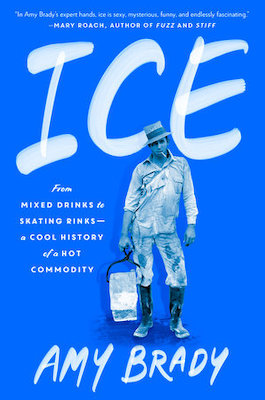Back in high school in the 1990s, I was taught history with a capital “H,” the kind of history that focused on a single narrative. It was a view of history that revealed only the narrowest strip of the past, a thin swath of experience from which many people, places, and ideas were excluded.
Microhistories are a type of nonfiction that looks at history through the lens of a single object or substance. They show us how ubiquitous, everyday objects—the kinds many of us never think twice about—are actually the physical culmination of centuries of experimentation, violent clashes between some people, and hopeful collaborations among others. They reveal how communities, territories, and nations are stratified by race, gender, ability, and economic class by telling us who had access to such objects and who did not have access. Microhistories can tell us so much about who we are as a society by revealing how and why the objects became popular in the first place.
My book Ice: From Mixed Drinks to Skating Rinks—a Cool History of a Hot Commodity at America’s past through the prism of one of the most commonplace objects of all—ice. This frozen object illuminates aspects of history that we may not learn otherwise: For example, the public’s response of “blasphemy!” to the invention of mechanically-made ice highlights America’s founding as a puritanical nation. Ice skating provided young lovers with the opportunity to enjoy each other’s company beyond the watchful eye of guardians, and through this, we discover 19th-century social norms surrounding courtship. I also delve into the ways in which ice made some people very rich—and left others with nothing—revealing a history of class inequality, whose legacy is still felt today at expensive craft cocktail bars and on the price tags of tabletop luxury ice machines.
To celebrate the release of Ice—and the genre more generally—here are seven must-read microhistories that teach us so much about our past in the most surprising and multifaceted ways.
Indigo: In Search of the Color That Seduced the World by Catherine McKinley
Mixing history and memoir, Indigo tells the fascinating tale of how a mysterious color influenced everything from the fashion industry to the world’s major religions. McKinley weaves an exploration of her own family’s history throughout the book, highlighting the ways in which indigo touched the lives of her Jewish, Scottish, and African descendants. From these various connections arises a fresh look at colonial history, changing forever how you think of color.
Pipe Dreams: The Urgent Global Quest to Transform the Toilet by Chelsea Wald
This amusing microhistory is as entertaining as it is smart. Wald interviews scientists, engineers, waste experts, and others around the world to learn why toilets play such an important role in agriculture, public health, and environmental safety. By looking at the globe through such a surprising lens, she reveals just how important (and luxurious) it is to have access to effective waste management—and why more than half of our world’s population lack such facilities.
Coal: A Human History by Barbara Freese
Coal transformed the planet. It gave rise to new civilizations, launched world economies, made new kinds of industry possible, and now, is a key contributor to climate change. In her breathtaking examination of the mineral, Freese examines what made coal such a transformative fuel and why it has an outsized impact on the world as we know it. In the latest edition of the book, Freese includes a chapter on how those who seek to defend humanity’s use of coal are facing increasing push-back from activists seeking to end our species’ dependency on it for fuel.
Brolliology: A History of the Umbrella in Life and Literature by Marion Rankine
In case there is any doubt that no object is too commonplace to be written about, Marion Rankine gives us a history of the umbrella. The book is beautifully illustrated, with amusing references to Derrida and Dickens, and anecdotes about the ways in which some of the most revered thinkers and writers throughout history have considered the cultural importance of umbrellas. Like the best of the genre, Rankine also makes connections between her object of study and larger meditations on race, gender, and economic class.
Eyeliner by Zahra Hankir
In this endlessly fascinating book, Hankir explores how eyeliner—the nearly universal makeup tool used by so many contemporary women—has a richer and sometimes stranger history than many people (including me) would have guessed. Beyond its use as a tool to enhance beauty, it’s been used throughout history in cultures around the world as part of religious ceremonies, to ward off evil spirits, and to push the boundaries of gender norms. Readers will never think of eyeliner the same way after reading this book.
Consider the Fork: A History of How We Cook and Eat by Bee Wilson
Acclaimed food writer Bee Wilson reveals how the fork and other culinary technologies changed how people eat, cook, and serve meals. She covers prehistoric uses of food-related tools (such as rocks and rudimentary bowls) as well as more modern inventions, like the microwave. Wilson’s style is both funny and informative, and the history she reveals shows just how important the fork is and how its legacy of kitchen technologies have changed not only the food on our tables, but the roles that food plays in our ceremonies, social gatherings, and everyday lives.
Pockets: An Intimate History of How We Keep Things Close by Hannah Carlson
Written by a lecturer in dress history at the Rhode Island School of Design, this captivating book looks at how pockets in clothing (or, in some cases, the absence of pockets) illuminate larger issues of gender, power, and privilege. The book spans a long stretch of history, from at least medieval Europe through today, stopping to examine some of the most famous pockets in history—including those of Abraham Lincoln. By focusing on the tiny object of the pocket, Carlson reveals how clothing can reflect the value systems of the world around us.
This post was originally published on this site be sure to check out more of their content.









